Global Battery Market Forecast
- The approximately US$105.2 Bn battery market (2022) to reach US$302.7 Bn by 2030
- Battery market size poised to rise high at a CAGR of 16.3% during 2023 - 2030
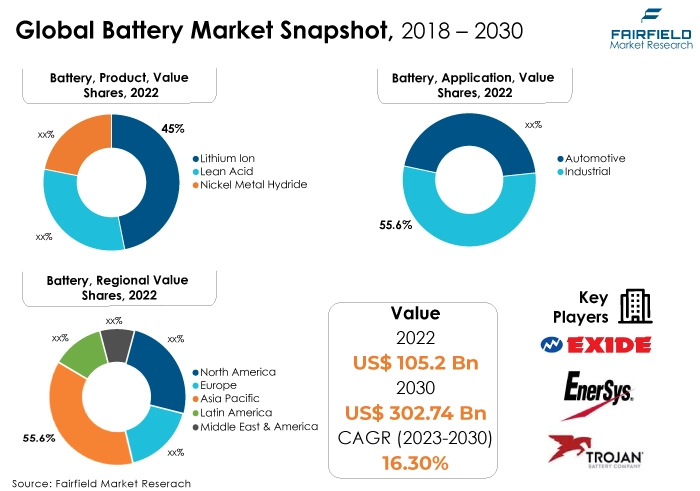
Significant Report Findings - Fairfield's Perspective
- The critical trend anticipated to fuel the battery market growth is increased demand for hybrid and electric vehicles (EVs). Consumers increasingly opt for these vehicles to reduce emissions and lower operating costs.
- Another major market trend expected to fuel the battery market growth is the rapidly expanding new hybrid & electric automotive models from OEMs. The innovative vehicles are equipped with advanced battery technologies to meet growing consumer demand for eco-friendly transportation options.
- In 2022, the lithium-ion category dominated the industry. The demand has surged with the growing popularity of EVs, and renewable energy storage solutions.
- Regarding market share for battery globally, the automobile segment is anticipated to dominate. The growing demand for eco-friendly transportation options has driven significant advancements in battery technology.
- In 2022, the industrial category controlled the market. Batteries store energy from renewable sources, manage peak loads, and provide backup power during grid outages.
- The Asia Pacific region is anticipated to account for the largest share of the global Battery market, owing to various factors such as rapid industrialisation, burgeoning consumer electronics market, rising electric vehicle adoption, and rising investment in EV infrastructure.
- The market for battery is expanding in North America due to the rise in adoption of EVs, the growing need for energy storage solutions, rising collaborations between technology companies and research institutions, and government initiatives and regulations promoting clean energy solutions.
Current, Historical, and Futuristic Analysis
The battery market has grown in popularity due to factors such as increasing demand for EVs and renewable energy storage solutions. Lithium-ion batteries dominated the market, focusing on improving energy density and reducing costs. However, market dynamics may have evolved since then, influenced by technological advancements, government policies, and environmental concerns.
The market witnessed staggered growth during the historical period 2018 – 2022. This is due to the increased demand for portable electronic devices, electric vehicles, and renewable energy storage. Technological advancements and environmental concerns have spurred innovation in battery technology, with lithium-ion batteries dominating the market. The market has seen consolidation and fierce competition among major players.
With the increasing demand for EVs, renewable energy storage solutions, and portable electronic devices, the market is expected to expand rapidly. Environmental concerns and government incentives for sustainable energy solutions will further boost market growth. As a result, the global battery market is anticipated to thrive in the coming years, offering substantial opportunities for established players and new entrants.
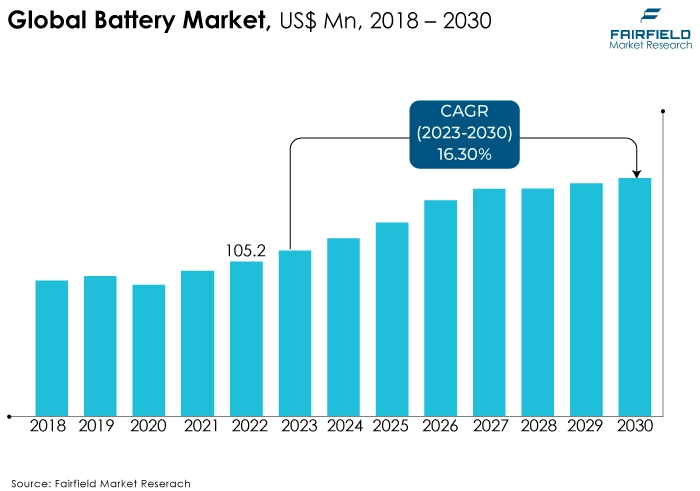
Key Growth Factors
- Growing Integration with Electronics
The proliferation of smartphones, tablets, and wearable devices has created a massive demand for compact and high-capacity batteries to power these gadgets, fostering innovation in battery technology. Moreover, the increasing adoption of EVs and renewable energy sources relies heavily on advanced battery solutions for energy storage and transportation.
The demand for efficient and eco-friendly batteries continues to rise as the world shifts towards a greener future. Additionally, the Internet of Things (IoT) revolution has led to an explosion of connected devices in industries such as healthcare, agriculture, and smart homes.
- Growing Demand in Transportation Sector
EVs are becoming increasingly popular due to their environmental benefits and lower operating costs than traditional internal combustion engines. EVs rely on advanced battery technology for energy storage, driving the demand for high-performance batteries like lithium-ion batteries.
Furthermore, governments worldwide are implementing stringent emissions regulations and offering incentives to promote electric mobility, further boosting the need for batteries in transportation. As consumers become more environmentally aware, they are increasingly adopting electric options, including electric bicycles, scooters, buses, and cars.
- Fuel Savings, and Government Incentives for Cleaner Transportation
The world increasingly prioritises sustainability and energy efficiency; batteries are pivotal in EVs and hybrid cars. These batteries store energy efficiently, reducing the reliance on fossil fuels and resulting in substantial fuel savings for consumers.
Moreover, governments worldwide are offering incentives and subsidies to promote the adoption of cleaner transportation options. These incentives include tax credits, rebates, and reduced registration fees for electric and hybrid vehicles.
Policies enforcing stricter emission standards also push automakers to invest in battery technology to meet compliance, further boosting the battery market's growth.
Major Growth Barriers
- Underdeveloped EV Infrastructure
In many regions, there needs to be charging stations, maintenance facilities, and skilled technicians needed to support the widespread adoption of EVs. Without a robust support ecosystem, potential EV buyers are deterred by concerns about range anxiety and limited access to essential services, slowing down the overall expansion of the battery market.
- Safety Issues Related to Battery Usage are Hindering Market Expansion
Lithium-ion batteries, commonly used in various applications, are susceptible to overheating, causing thermal runaway and potentially leading to fires or explosions. Moreover, issues like manufacturing defects, punctures, or overcharging can further escalate safety risks. These concerns pose a threat to users and raise regulatory and liability challenges for manufacturers. Consequently, addressing safety issues and developing safer battery technologies remain critical for sustainable growth in the global battery market.
Key Trends and Opportunities to Look at
- Growing Demand for Hybrid & EVs
The increasing environmental consciousness, government incentives, and advancements in battery technology are driving market expansion. Consumers increasingly opt for these vehicles to reduce emissions and lower operating costs. As a result, there is a heightened need for high-performance batteries to power these vehicles, thereby boosting the global battery market's growth.
- Rising R&D in Batteries for Hybrid & EVs
The extensive research and development (R&D) efforts focused on advancing battery technologies for hybrid and EVs. These investments are crucial for improving energy density, reducing costs, and enhancing the overall performance and longevity of batteries, ultimately accelerating the adoption of eco-friendly transportation solutions, and addressing environmental concerns.
- Entry of New Hybrid & Electric Automotive Models
The innovative vehicles are equipped with advanced battery technologies to meet growing consumer demand for eco-friendly transportation options. As consumers increasingly prioritise sustainability and fuel efficiency, OEMs invest in cutting-edge battery solutions, spurring market growth. This trend reduces greenhouse gas emissions and promotes the adoption of cleaner energy sources in the automotive sector, driving the expansion of the global battery market.
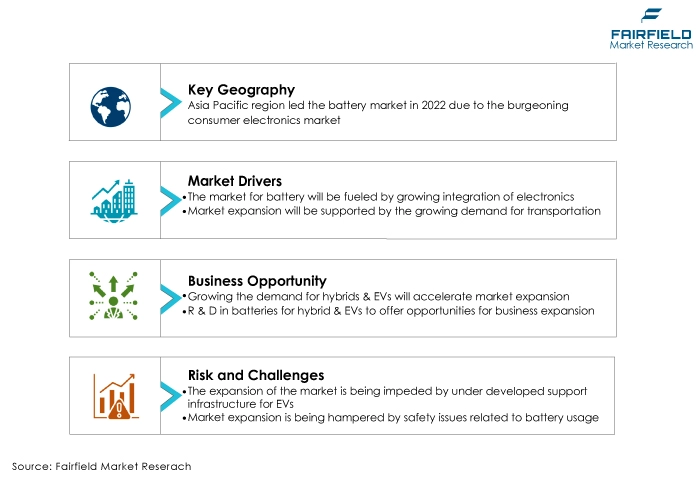
How Does the Regulatory Scenario Shape this Industry?
Over the last three years, the rapid growth of the industry has been due to the international harmonisation of standards environmental and safety concerns by the regulatory bodies. The International Electrotechnical Commission (IEC) sets international standards for battery performance, safety, and labelling, ensuring that batteries meet specific quality and safety requirements for global markets.
The United Nations Economic Commission for Europe (UNECE) also plays a crucial role in harmonizing regulations for transporting dangerous goods, including batteries. On the environmental front, the European Union (EU) has implemented strict rules such as the Battery Regulation (EU) 2020/1029, which mandates sustainable battery design, recycling targets, and restrictions on hazardous substances in batteries.
Furthermore, national agencies like the China National Energy Administration (NEA) and the Japan Electrical Manufacturers' Association (JEMA) have their own regulations and standards impacting the battery industry within their respective countries. Adherence to these regulations is crucial for industry players to navigate this ever-evolving sector.
Fairfield’s Ranking Board
Top Segments
- Lithium-ion Battery Most Prominent
The lithium-ion segment dominated the market in 2022. Batteries have become the primary choice for portable electronic devices like smartphones, laptops, and EVs due to their consistent power and fast charging capabilities.
The demand for Li-ion batteries has surged with the growing popularity of EVs and renewable energy storage solutions, as they offer efficient energy storage and reduced environmental impact.
Furthermore, the lean acid category is projected to experience the fastest market growth. Batteries are heavier and bulkier than Li-ion batteries, and used in applications such as automotive starting batteries and uninterruptible power supplies (UPS). They are cost-effective and reliable, making them suitable for industries where performance requirements are less demanding.
- Automobile Industry Continues to Surge Ahead of Others
In 2022, the automobile category dominated the industry. The automatic case packers are designed to process a greater. The growing demand for eco-friendly transportation options has driven significant advancements in battery technology. Lithium-ion batteries are commonly used in EVs due to their high energy density and performance.
Moreover, expanding charging infrastructure and government incentives for EV adoption further stimulate this segment's growth. The electronics category is anticipated to grow substantially throughout the projected period. Batteries are crucial in providing portable power solutions for these devices.
With the increasing reliance on electronic gadgets in our daily lives, there is a constant demand for more efficient and longer-lasting batteries. Advancements in lithium-ion and solid-state battery technologies are transforming the electronics industry by offering improved energy storage solutions and enabling the development of smaller, more compact devices.
- Industrial Sector Holds the Maximum Opportunity
The industrial segment dominated the market in 2022. In manufacturing, telecommunications, data centres, and renewable energy industries, batteries store energy from renewable sources, manage peak loads, and provide backup power during grid outages. Lithium-ion batteries, lead-acid batteries, and advanced energy storage solutions are commonly used in these applications.
The automotive category is expected to experience the fastest growth within the forecast time frame. EVs, and hybrid electric vehicles (HEVs) rely on high-capacity batteries for propulsion. These batteries must provide long-range capabilities, fast charging, and durability. With the increasing adoption of EVs and the transition towards sustainable transportation, the automotive battery segment is experiencing rapid growth.
Regional Frontrunners
China’s Global Leadership in Battery Production and Consumption Makes Asia Pacific the Topmost Regional Market
In the power generation industries, battery adoption is anticipated to dominate Asia Pacific. The rapid industrialisation and burgeoning consumer electronics market helped drive market expansion in the area. China especially dominates the market as the world's largest producer and consumer of batteries, driven by electric vehicle adoption and renewable energy initiatives.
In addition, the region benefits from government incentives promoting clean energy and energy storage solutions, further boosting battery demand. As Asia-Pacific continues to invest in EV infrastructure and renewable energy projects, the regional battery market is expected to experience substantial growth, making it a key player in the global battery industry's evolution.
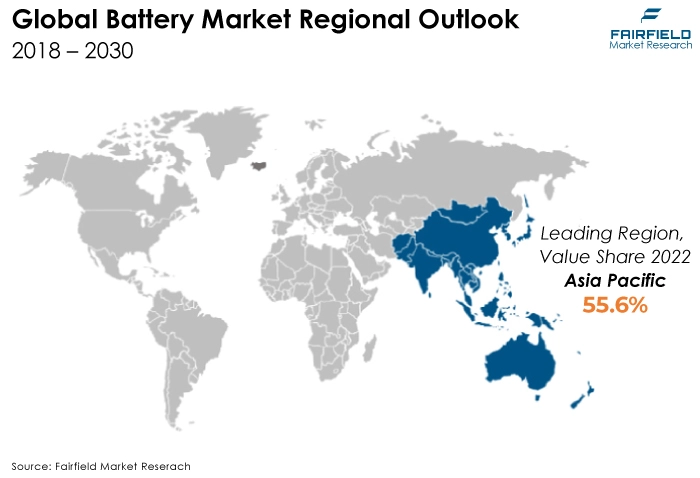
North America is the Next Leg of Growth for Market
The increasing adoption of EVs and renewable energy sources drives expansion in the North American battery market. Moreover, government incentives and environmental regulations promoting clean energy solutions have further accelerated this growth.
The US remains a dominant battery market player, with significant investment in battery manufacturing facilities. Additionally, collaborations between technology companies and research institutions foster innovation and drive the market forward.
Canada also plays a vital role in developing advanced battery technologies for various applications. North America's battery market continues to expand, driven by the rising need for energy storage solutions and sustainable transportation options.
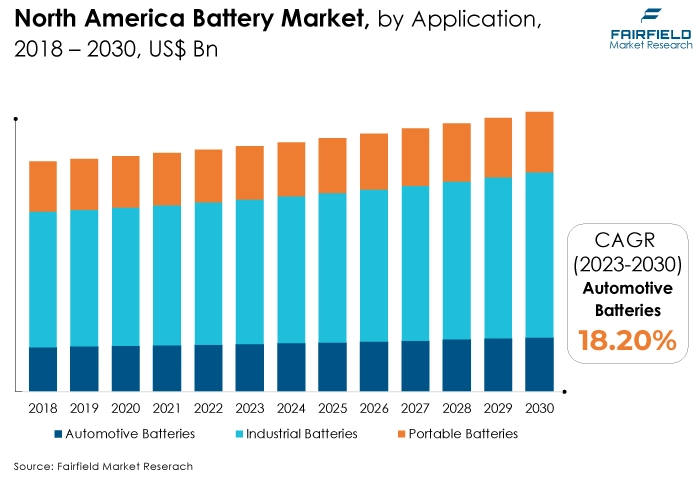
Fairfield’s Competitive Landscape Analysis
The companies continuously innovate to improve battery energy density, lifespan, and safety, catering to applications like electric vehicles, renewable energy storage, and consumer electronics. Intense competition drives advancements in technology, cost reduction, and sustainability as companies vie for market share in this rapidly growing sector.
Who are the Leaders in the Global Battery Space?
- Exide Industries Ltd.
- Amara Raja Batteries Ltd.
- East Penn Manufacturing Industry Company
- ENERSYS
- Crown Equipment Corporation
- Trojan Battery Company
- Narada Power Source Co. Ltd
- Tesla, Inc.
- Panasonic Corporation
- LG Chem
- Samsung SDI
- BYD Company Limited
- A123 Systems
- Johnson Controls
- Duracell
Significant Company Developments
New Product Launches
- November 2022: Panasonic announced the construction of a new lithium-ion battery manufacturing area in De Soto, KS. It will drive significant economic activity and opportunities for the local Kansas economy, making it a major player in the domestic electric vehicle (EV) industry.
- January 2022: BYD and FAW planned a production area for electric car batteries in northeastern China, having an annual capacity of 45 GWh. It is a joint venture between BYD and FAW called FAW FinDreams New Energy Technology, established with a registered capital in EUR. BYD holds nearly 51% of the joint venture, and FAW Group owns the rest.
- June 2022: IIT Madras researchers made a new battery technology for electric cars. They developed mechanically rechargeable zinc-air batteries because they are more economical than the previous lithium-ion batteries and have a longer shelf life.
Distribution Agreements
- December 2022: Panasonic partnered with Lucid Group to supply EV batteries.
- February 2022: Panasonic Corporation propounded that its Energy Company will make a production facility at its Wakayama Factory in western Japan to produce huge cylindrical (46 mm wide and 80 mm tall) batteries for electric vehicles.
An Expert’s Eye
Demand and Future Growth
The rapid expansion of EVs, renewable energy integration, and increasing consumer electronics usage are driving the market. Technological advancements in lithium-ion batteries, solid-state batteries, and emerging chemistries are expected to fuel future growth, enhancing energy density and safety.
As the world transitions towards clean energy and transportation, the global battery market is poised for significant expansion, with sustained demand anticipated in the foreseeable future.
Supply Side of the Market
China is the world's largest producer and consumer of batteries due to the rising adoption of electric vehicles and renewable energy initiatives in the Asia Pacific region. In January 2022, Nexeon Limited, a producer of advanced silicon anode materials for next-generation lithium-ion batteries, provided a license to its NSP-1 technology to progressive material giant SKC Co. Ltd. It contributed to advancing the research of automotive batteries.
Battery producers are working on technologically advanced versions that require integrating automation, accuracy, and adaptability. Countries like India continue to invest in electric vehicle infrastructure projects to experience substantial growth.
The US is another major consumer and producer of batteries due to significant investments in battery manufacturing facilities in the North American region. Moreover, Canada contributes to developing advanced batteries in the North American area.
The Global Battery Market is Segmented as Below:
By Product:
- Lead Acid
- Lithium-ion
- Nickel Metal Hydride
- Nickel Cadmium
- Others
By End Use:
- Automobile
- Electronics
- Energy Storage
- Aerospace
- Military & Defense
- Others
By Application:
- Automotive Batteries
- Industrial Batteries
- Portable Batteries
By Geographic Coverage:
- North America
- U.S.
- Canada
- Europe
- Germany
- U.K.
- France
- Italy
- Turkey
- Russia
- Rest of Europe
- Asia Pacific
- China
- Japan
- South Korea
- India
- Southeast Asia
- Rest of Asia Pacific
- Latin America
- Brazil
- Mexico
- Argentina
- Rest of Latin America
- Middle East & Africa
- GCC
- South Africa
- Egypt
- Nigeria
- Rest of the Middle East & Africa
1. Executive Summary
1.1. Global Battery Market Snapshot
1.2. Future Projections
1.3. Key Market Trends
1.4. Regional Snapshot, by Value/Volume, 2022
1.5. Analyst Recommendations
2. Market Overview
2.1. Market Definitions and Segmentations
2.2. Market Dynamics
2.2.1. Drivers
2.2.2. Restraints
2.2.3. Market Opportunities
2.3. Value Chain Analysis
2.4. Porter’s Five Forces Analysis
2.5. COVID-19 Impact Analysis
2.5.1. Supply
2.5.2. Demand
2.6. Impact of Ukraine-Russia Conflict
2.7. Economic Overview
2.7.1. World Economic Projections
2.8. PESTLE Analysis
3. Production Output, by Region
4. Pricing Analysis, 2018-2022
5. Global Battery Market Outlook, 2018 - 2030
5.1. Global Battery Market Outlook, by Product, Value (US$ Bn), 2018 - 2030
5.1.1. Key Highlights
5.1.1.1. Lead Acid
5.1.1.2. Lithium Ion
5.1.1.3. Nickel Metal Hydride
5.1.1.4. Nickel Cadmium
5.1.1.5. Others
5.2. Global Battery Market Outlook, by End Use, Value (US$ Bn), 2018 - 2030
5.2.1. Key Highlights
5.2.1.1. Automobile
5.2.1.2. Electronics
5.2.1.3. Energy Storage
5.2.1.4. Aerospace
5.2.1.5. Military & Defense
5.2.1.6. Others
5.3. Global Battery Market Outlook, by Application, Value (US$ Bn), 2018 - 2030
5.3.1. Key Highlights
5.3.1.1. Automotive Batteries
5.3.1.2. Industrial Batteries
5.3.1.3. Portable Batteries
5.4. Global Battery Market Outlook, by Region, Value (US$ Bn), 2018 - 2030
5.4.1. Key Highlights
5.4.1.1. North America
5.4.1.2. Europe
5.4.1.3. Asia Pacific
5.4.1.4. Latin America
5.4.1.5. Middle East & Africa
6. North America Battery Market Outlook, 2018 - 2030
6.1. North America Battery Market Outlook, by Product, Value (US$ Bn), 2018 - 2030
6.1.1. Key Highlights
6.1.1.1. Lead Acid
6.1.1.2. Lithium Ion
6.1.1.3. Nickel Metal Hydride
6.1.1.4. Nickel Cadmium
6.1.1.5. Others
6.2. North America Battery Market Outlook, by End Use, Value (US$ Bn), 2018 - 2030
6.2.1. Key Highlights
6.2.1.1. Automobile
6.2.1.2. Electronics
6.2.1.3. Energy Storage
6.2.1.4. Aerospace
6.2.1.5. Military & Defense
6.2.1.6. Others
6.3. North America Battery Market Outlook, by Application, Value (US$ Bn), 2018 - 2030
6.3.1. Key Highlights
6.3.1.1. Automotive Batteries
6.3.1.2. Industrial Batteries
6.3.1.3. Portable Batteries
6.3.2. BPS Analysis/Market Attractiveness Analysis
6.4. North America Battery Market Outlook, by Country, Value (US$ Bn), 2018 - 2030
6.4.1. Key Highlights
6.4.1.1. U.S. Battery Market by Product, Value (US$ Bn), 2018 - 2030
6.4.1.2. U.S. Battery Market, by End Use, Value (US$ Bn), 2018 - 2030
6.4.1.3. U.S. Battery Market, by Application, Value (US$ Bn), 2018 - 2030
6.4.1.4. Canada Battery Market by Product, Value (US$ Bn), 2018 - 2030
6.4.1.5. Canada Battery Market, by End Use, Value (US$ Bn), 2018 - 2030
6.4.1.6. Canada Battery Market, by Application, Value (US$ Bn), 2018 - 2030
6.4.2. BPS Analysis/Market Attractiveness Analysis
7. Europe Battery Market Outlook, 2018 - 2030
7.1. Europe Battery Market Outlook, by Product, Value (US$ Bn), 2018 - 2030
7.1.1. Key Highlights
7.1.1.1. Lead Acid
7.1.1.2. Lithium Ion
7.1.1.3. Nickel Metal Hydride
7.1.1.4. Nickel Cadmium
7.1.1.5. Others
7.2. Europe Battery Market Outlook, by End Use, Value (US$ Bn), 2018 - 2030
7.2.1. Key Highlights
7.2.1.1. Automobile
7.2.1.2. Electronics
7.2.1.3. Energy Storage
7.2.1.4. Aerospace
7.2.1.5. Military & Defense
7.2.1.6. Others
7.3. Europe Battery Market Outlook, by Application, Value (US$ Bn), 2018 - 2030
7.3.1. Key Highlights
7.3.1.1. Automotive Batteries
7.3.1.2. Industrial Batteries
7.3.1.3. Portable Batteries
7.3.2. BPS Analysis/Market Attractiveness Analysis
7.4. Europe Battery Market Outlook, by Country, Value (US$ Bn), 2018 - 2030
7.4.1. Key Highlights
7.4.1.1. Germany Battery Market by Product, Value (US$ Bn), 2018 - 2030
7.4.1.2. Germany Battery Market, by End Use, Value (US$ Bn), 2018 - 2030
7.4.1.3. Germany Battery Market, by Application, Value (US$ Bn), 2018 - 2030
7.4.1.4. U.K. Battery Market by Product, Value (US$ Bn), 2018 - 2030
7.4.1.5. U.K. Battery Market, by End Use, Value (US$ Bn), 2018 - 2030
7.4.1.6. U.K. Battery Market, by Application, Value (US$ Bn), 2018 - 2030
7.4.1.7. France Battery Market by Product, Value (US$ Bn), 2018 - 2030
7.4.1.8. France Battery Market, by End Use, Value (US$ Bn), 2018 - 2030
7.4.1.9. France Battery Market, by Application, Value (US$ Bn), 2018 - 2030
7.4.1.10. Italy Battery Market by Product, Value (US$ Bn), 2018 - 2030
7.4.1.11. Italy Battery Market, by End Use, Value (US$ Bn), 2018 - 2030
7.4.1.12. Italy Battery Market, by Application, Value (US$ Bn), 2018 - 2030
7.4.1.13. Turkey Battery Market by Product, Value (US$ Bn), 2018 - 2030
7.4.1.14. Turkey Battery Market, by End Use, Value (US$ Bn), 2018 - 2030
7.4.1.15. Turkey Battery Market, by Application, Value (US$ Bn), 2018 - 2030
7.4.1.16. Russia Battery Market by Product, Value (US$ Bn), 2018 - 2030
7.4.1.17. Russia Battery Market, by End Use, Value (US$ Bn), 2018 - 2030
7.4.1.18. Russia Battery Market, by Application, Value (US$ Bn), 2018 - 2030
7.4.1.19. Rest of Europe Battery Market by Product, Value (US$ Bn), 2018 - 2030
7.4.1.20. Rest of Europe Battery Market, by End Use, Value (US$ Bn), 2018 - 2030
7.4.1.21. Rest of Europe Battery Market, by Application, Value (US$ Bn), 2018 - 2030
7.4.2. BPS Analysis/Market Attractiveness Analysis
8. Asia Pacific Battery Market Outlook, 2018 - 2030
8.1. Asia Pacific Battery Market Outlook, by Product, Value (US$ Bn), 2018 - 2030
8.1.1. Key Highlights
8.1.1.1. Lead Acid
8.1.1.2. Lithium Ion
8.1.1.3. Nickel Metal Hydride
8.1.1.4. Nickel Cadmium
8.1.1.5. Others
8.2. Asia Pacific Battery Market Outlook, by End Use, Value (US$ Bn), 2018 - 2030
8.2.1. Key Highlights
8.2.1.1. Automobile
8.2.1.2. Electronics
8.2.1.3. Energy Storage
8.2.1.4. Aerospace
8.2.1.5. Military & Defense
8.2.1.6. Others
8.3. Asia Pacific Battery Market Outlook, by Application, Value (US$ Bn), 2018 - 2030
8.3.1. Key Highlights
8.3.1.1. Automotive Batteries
8.3.1.2. Industrial Batteries
8.3.1.3. Portable Batteries
8.3.2. BPS Analysis/Market Attractiveness Analysis
8.4. Asia Pacific Battery Market Outlook, by Country, Value (US$ Bn), 2018 - 2030
8.4.1. Key Highlights
8.4.1.1. China Battery Market by Product, Value (US$ Bn), 2018 - 2030
8.4.1.2. China Battery Market, by End Use, Value (US$ Bn), 2018 - 2030
8.4.1.3. China Battery Market, by Application, Value (US$ Bn), 2018 - 2030
8.4.1.4. Japan Battery Market by Product, Value (US$ Bn), 2018 - 2030
8.4.1.5. Japan Battery Market, by End Use, Value (US$ Bn), 2018 - 2030
8.4.1.6. Japan Battery Market, by Application, Value (US$ Bn), 2018 - 2030
8.4.1.7. South Korea Battery Market by Product, Value (US$ Bn), 2018 - 2030
8.4.1.8. South Korea Battery Market, by End Use, Value (US$ Bn), 2018 - 2030
8.4.1.9. South Korea Battery Market, by Application, Value (US$ Bn), 2018 - 2030
8.4.1.10. India Battery Market by Product, Value (US$ Bn), 2018 - 2030
8.4.1.11. India Battery Market, by End Use, Value (US$ Bn), 2018 - 2030
8.4.1.12. India Battery Market, by Application, Value (US$ Bn), 2018 - 2030
8.4.1.13. Southeast Asia Battery Market by Product, Value (US$ Bn), 2018 - 2030
8.4.1.14. Southeast Asia Battery Market, by End Use, Value (US$ Bn), 2018 - 2030
8.4.1.15. Southeast Asia Battery Market, by Application, Value (US$ Bn), 2018 - 2030
8.4.1.16. Rest of Asia Pacific Battery Market by Product, Value (US$ Bn), 2018 - 2030
8.4.1.17. Rest of Asia Pacific Battery Market, by End Use, Value (US$ Bn), 2018 - 2030
8.4.1.18. Rest of Asia Pacific Battery Market, by Application, Value (US$ Bn), 2018 - 2030
8.4.2. BPS Analysis/Market Attractiveness Analysis
9. Latin America Battery Market Outlook, 2018 - 2030
9.1. Latin America Battery Market Outlook, by Product, Value (US$ Bn), 2018 - 2030
9.1.1. Key Highlights
9.1.1.1. Lead Acid
9.1.1.2. Lithium Ion
9.1.1.3. Nickel Metal Hydride
9.1.1.4. Nickel Cadmium
9.1.1.5. Others
9.2. Latin America Battery Market Outlook, by End Use, Value (US$ Bn), 2018 - 2030
9.2.1. Key Highlights
9.2.1.1. Automobile
9.2.1.2. Electronics
9.2.1.3. Energy Storage
9.2.1.4. Aerospace
9.2.1.5. Military & Defense
9.2.1.6. Others
9.3. Latin America Battery Market Outlook, by Application, Value (US$ Bn), 2018 - 2030
9.3.1. Key Highlights
9.3.1.1. Automotive Batteries
9.3.1.2. Industrial Batteries
9.3.1.3. Portable Batteries
9.3.2. BPS Analysis/Market Attractiveness Analysis
9.4. Latin America Battery Market Outlook, by Country, Value (US$ Bn), 2018 - 2030
9.4.1. Key Highlights
9.4.1.1. Brazil Battery Market by Product, Value (US$ Bn), 2018 - 2030
9.4.1.2. Brazil Battery Market, by End Use, Value (US$ Bn), 2018 - 2030
9.4.1.3. Brazil Battery Market, by Application, Value (US$ Bn), 2018 - 2030
9.4.1.4. Mexico Battery Market by Product, Value (US$ Bn), 2018 - 2030
9.4.1.5. Mexico Battery Market, by End Use, Value (US$ Bn), 2018 - 2030
9.4.1.6. Mexico Battery Market, by Application, Value (US$ Bn), 2018 - 2030
9.4.1.7. Argentina Battery Market by Product, Value (US$ Bn), 2018 - 2030
9.4.1.8. Argentina Battery Market, by End Use, Value (US$ Bn), 2018 - 2030
9.4.1.9. Argentina Battery Market, by Application, Value (US$ Bn), 2018 - 2030
9.4.1.10. Rest of Latin America Battery Market by Product, Value (US$ Bn), 2018 - 2030
9.4.1.11. Rest of Latin America Battery Market, by End Use, Value (US$ Bn), 2018 - 2030
9.4.1.12. Rest of Latin America Battery Market, by Application, Value (US$ Bn), 2018 - 2030
9.4.2. BPS Analysis/Market Attractiveness Analysis
10. Middle East & Africa Battery Market Outlook, 2018 - 2030
10.1. Middle East & Africa Battery Market Outlook, by Product, Value (US$ Bn), 2018 - 2030
10.1.1. Key Highlights
10.1.1.1. Lead Acid
10.1.1.2. Lithium Ion
10.1.1.3. Nickel Metal Hydride
10.1.1.4. Nickel Cadmium
10.1.1.5. Others
10.2. Middle East & Africa Battery Market Outlook, by End Use, Value (US$ Bn), 2018 - 2030
10.2.1. Key Highlights
10.2.1.1. Automobile
10.2.1.2. Electronics
10.2.1.3. Energy Storage
10.2.1.4. Aerospace
10.2.1.5. Military & Defense
10.2.1.6. Others
10.3. Middle East & Africa Battery Market Outlook, by Application, Value (US$ Bn), 2018 - 2030
10.3.1. Key Highlights
10.3.1.1. Automotive Batteries
10.3.1.2. Industrial Batteries
10.3.1.3. Portable Batteries
10.3.2. BPS Analysis/Market Attractiveness Analysis
10.4. Middle East & Africa Battery Market Outlook, by Country, Value (US$ Bn), 2018 - 2030
10.4.1. Key Highlights
10.4.1.1. GCC Battery Market by Product, Value (US$ Bn), 2018 - 2030
10.4.1.2. GCC Battery Market, by End Use, Value (US$ Bn), 2018 - 2030
10.4.1.3. GCC Battery Market, by Application, Value (US$ Bn), 2018 - 2030
10.4.1.4. South Africa Battery Market by Product, Value (US$ Bn), 2018 - 2030
10.4.1.5. South Africa Battery Market, by End Use, Value (US$ Bn), 2018 - 2030
10.4.1.6. South Africa Battery Market, by Application, Value (US$ Bn), 2018 - 2030
10.4.1.7. Egypt Battery Market by Product, Value (US$ Bn), 2018 - 2030
10.4.1.8. Egypt Battery Market, by End Use, Value (US$ Bn), 2018 - 2030
10.4.1.9. Egypt Battery Market, by Application, Value (US$ Bn), 2018 - 2030
10.4.1.10. Nigeria Battery Market by Product, Value (US$ Bn), 2018 - 2030
10.4.1.11. Nigeria Battery Market, by End Use, Value (US$ Bn), 2018 - 2030
10.4.1.12. Nigeria Battery Market, by Application, Value (US$ Bn), 2018 - 2030
10.4.1.13. Rest of Middle East & Africa Battery Market by Product, Value (US$ Bn), 2018 - 2030
10.4.1.14. Rest of Middle East & Africa Battery Market, by End Use, Value (US$ Bn), 2018 - 2030
10.4.1.15. Rest of Middle East & Africa Battery Market, by Application, Value (US$ Bn), 2018 - 2030
10.4.2. BPS Analysis/Market Attractiveness Analysis
11. Competitive Landscape
11.1. Manufacturer vs Application Heatmap
11.2. Company Market Share Analysis, 2022
11.3. Competitive Dashboard
11.4. Company Profiles
11.4.1. Exide Industries Ltd.
11.4.1.1. Company Overview
11.4.1.2. Product Portfolio
11.4.1.3. Financial Overview
11.4.1.4. Business Strategies and Development
11.4.2. Amara Raja Batteries Ltd.
11.4.2.1. Company Overview
11.4.2.2. Product Portfolio
11.4.2.3. Financial Overview
11.4.2.4. Business Strategies and Development
11.4.3. East Penn Manufacturing Industry Company
11.4.3.1. Company Overview
11.4.3.2. Product Portfolio
11.4.3.3. Financial Overview
11.4.3.4. Business Strategies and Development
11.4.4. ENERSYS
11.4.4.1. Company Overview
11.4.4.2. Product Portfolio
11.4.4.3. Financial Overview
11.4.4.4. Business Strategies and Development
11.4.5. Crown Equipment Corporation
11.4.5.1. Company Overview
11.4.5.2. Product Portfolio
11.4.5.3. Financial Overview
11.4.5.4. Business Strategies and Development
11.4.6. Trojan Battery Company
11.4.6.1. Company Overview
11.4.6.2. Product Portfolio
11.4.6.3. Financial Overview
11.4.6.4. Business Strategies and Development
11.4.7. Narada Power Source Co. Ltd.
11.4.7.1. Company Overview
11.4.7.2. Product Portfolio
11.4.7.3. Financial Overview
11.4.7.4. Business Strategies and Development
11.4.8. Tesla Inc.
11.4.8.1. Company Overview
11.4.8.2. Product Portfolio
11.4.8.3. Financial Overview
11.4.8.4. Business Strategies and Development
11.4.9. Panasonic Corporation
11.4.9.1. Company Overview
11.4.9.2. Product Portfolio
11.4.9.3. Business Strategies and Development
11.4.10. LG Chem
11.4.10.1. Company Overview
11.4.10.2. Product Portfolio
11.4.10.3. Financial Overview
11.4.10.4. Business Strategies and Development
11.4.11. Samsung SDI
11.4.11.1. Company Overview
11.4.11.2. Product Portfolio
11.4.11.3. Financial Overview
11.4.11.4. Business Strategies and Development
11.4.12. BYD Company Limited
11.4.12.1. Company Overview
11.4.12.2. Product Portfolio
11.4.12.3. Financial Overview
11.4.12.4. Business Strategies and Development
11.4.13. A123 Systems
11.4.13.1. Company Overview
11.4.13.2. Product Portfolio
11.4.13.3. Financial Overview
11.4.13.4. Business Strategies and Development
11.4.14. Johnson Controls
11.4.14.1. Company Overview
11.4.14.2. Product Portfolio
11.4.14.3. Financial Overview
11.4.14.4. Business Strategies and Development
11.4.15. Duracell
11.4.15.1. Company Overview
11.4.15.2. Product Portfolio
11.4.15.3. Financial Overview
11.4.15.4. Business Strategies and Development
12. Appendix
12.1. Research Methodology
12.2. Report Assumptions
12.3. Acronyms and Abbreviations
|
BASE YEAR |
HISTORICAL DATA |
FORECAST PERIOD |
UNITS |
|||
|
2022 |
|
2018 - 2022 |
2023 - 2030 |
Value: US$ Million |
||
|
REPORT FEATURES |
DETAILS |
|
Product Coverage |
|
|
End Use Coverage |
|
|
Application Coverage |
|
|
Geographical Coverage |
|
|
Leading Companies |
|
|
Report Highlights |
Key Market Indicators, Macro-micro economic impact analysis, Technological Roadmap, Key Trends, Driver, Restraints, and Future Opportunities & Revenue Pockets, Porter’s 5 Forces Analysis, Historical Trend (2019-2021), Market Estimates and Forecast, Market Dynamics, Industry Trends, Competition Landscape, Category, Region, Country-wise Trends & Analysis, COVID-19 Impact Analysis (Demand and Supply Chain) |
